Guest blogged by Ellen Theisen, Co-Director of VotersUnite.Org
Yesterday I discussed the dangers presented by Rush Holt's Election Reform bill, HR 811, now pending a floor vote in the House. I detailed seven points which, taken as a whole, lead me to believe that the bill does more harm than good.
Senator Dianne Feinstein’s bill S. 1487, “The Ballot Integrity Act of 2007,” was introduced on May 24, 2007. Some were expecting it to be a companion to, and improvement on, Holt’s bill, H.R. 811. Far from an improvement, S. 1487 introduces surprising — and disturbing — new provisions.
It includes many of the most troubling points of the Holt bill, but goes even farther in the wrong direction away from what is needed for Electoral Integrity in America, presenting instead a grave danger to our democracy.
The bill systematically dismantles government by the people, and it provides a legal excuse for expanding the disenfranchisement of “distinct communities” such as racial minorities.
(The following excerpt discusses only how S. 1487 functions like a Voting Rights Act in reverse. I've posted a more complete analysis of the bill at VotersUnite.org.)
Historically, racial minorities have been prevented from voting by violence, poll taxes, highly subjective literacy tests, police dogs, and so on. The Voting Rights Act of 1965 was landmark legislation to remove such obstacles and clear the path for all voters to have a voice in elections.
A shameful provision in S. 1487 functions as a Voting Rights Act in reverse. “They” (historically disenfranchised communities) would get to vote, but the bill allows for the future massive loss of “their” voices through machine malfunction or other means, while limiting the vote loss that would be acceptable in jurisdictions where “they” aren’t as predominant....
The bill would give the U.S. Election Assistance Commission (EAC) the authority and discretion to review the historical disenfranchisement of “distinct communities” (such as racial minorities) in some jurisdictions and expand that disenfranchisement to all jurisdictions where those communities have a “substantial presence.”
[A note about the agency to which the bill would give this historic discretion: Reports from the Government Accountability Office reveal that the EAC is incompetent, behind schedule by years, and derelict in their duties. Recent news articles regarding their suppression and subsequent altering of a voter fraud report, along with their undisclosed disapproval of CIBER voting system test labs, has shown that the EAC is partisan and secretive. The process by which the 2005 federal voting systems standards were developed show that the agency is unduly influenced by the interests of voting system manufacturers.]
A Brief Background on Undervoting. To understand how the bill provides a legal excuse for expanding the disenfranchisement of racial minorities and other “distinct communities,” some background information is necessary. An “undervote” for a particular contest occurs when a vote for that contest is not counted on a ballot. In a secret ballot system, such as we have in the U.S., it is impossible for anyone other than the voter to know whether an undervote is the voter’s choice or caused by a mis-tabulation of some kind.
Election administrators and others who study election returns agree that many voters intentionally undervote in down-ticket contests, such as “Judge” or “Proposition 2.” However, these experts also agree that the percentage of intentional undervotes in federal contests is very low, so researchers routinely study Presidential undervote rates to compare the accuracy of the tabulation process in various jurisdictions.
A Presidential undervote rate of 0.5% (1 undervote out of every 200 ballots) is generally thought to indicate that virtually all votes were tabulated. A rate of 2% (1 out of 50) or more is generally thought to suggest a possible breakdown in the tabulation process, such as an equipment malfunction or even deliberate disenfranchisement.
Results have surfaced in many minority precincts around the country where, for example, 8% of the ballots fail to record a vote for President, compared to 2% of ballots in majority white precincts. Attempts have been made to attribute this discrepancy to “indecision” or “lack of interest” of the minority voters, despite those voters’ claims to the contrary. Research confirms the voter’s claims [PDF], pointing instead to possibly flawed machines or outright election fraud.
What S. 1487 Would Do. The bill would give the EAC sole authority to establish a national maximum undervote percentage, called a “benchmark.” The purpose of undervote studies has always been to detect the loss of valid votes and attempt to identify and eliminate the causes. Such a benchmark could be valuable as a red flag to States to investigate potential tabulation problems in areas that exceeded the benchmark.
However, under S. 1487, the benchmark would not be used to spur investigation into potential tabulation problems. Instead, the bill would require the impossible. The benchmark would establish an undervote rate “that States may not exceed.” How does Congress expect States to control the undervote rate?
This and other questions the mandate raises suggest potential confusion and even danger as the details of enforcement would be worked out in the courts. What is the consequence if a State exceeded the benchmark? Would a State be required to adjust the vote count (after the canvass) to meet the benchmark? Would the election be void, would the State have to hold a new election, or would the State be penalized in some other way? The bill answers none of these questions.
But this bill is shameful as well as dangerous.
The bill states: “Congress finds that there are certain distinct communities in certain geographic areas that have historically high rates of intentional undervoting in elections for Federal office, relative to the rest of the Nation.”
This “finding” is a deceit. Remember, there is no way to determine the rate of intentional undervoting in a secret ballot system.
But the bill goes on to declare that the EAC may determine which “distinct communities” have a historically high intentional undervote rate and may either set a different benchmark for “local jurisdictions in which that distinct community has a substantial presence” or exempt those jurisdictions from compliance with the national benchmark. So, the exemption wouldn’t just apply to the jurisdictions that had the high undervote rate; it could apply to all jurisdictions across the country that have a “substantial presence” of that “distinct community.”
So, for example, the EAC might use the 2002 election fiasco in Florida’s Miami-Dade County to conclude that African American communities intentionally undervote at rates as high as 28% in federal contests. Then they could declare that all precincts across the country with a “substantial presence” of African Americans will be allowed a higher Presidential undervote rate than other precincts.
Or, the EAC could use the scandalous 2004 election in New Mexico [PDF] to conclude that precincts with predominantly Native American voters have three to four times as many lost votes for President as the national average. Then they could provide legal cover for the expanded disenfranchisement of Native American voters at that same rate, in whatever jurisdictions across the country have a “substantial presence” of Native Americans.
After the Civil War, one of the provisions aimed at excluding African Americans from voting allowed a person to vote only if his grandfather had the right to vote. S. 1487 follows that tradition by “grandfathering in” disenfranchisement in a new way.
Proposing to legitimize such a scheme in federal law is a disgrace. Potential Consequences for Other “Distinct Communities.” Definitions are missing for two important terms in this provision — “distinct communities” and “substantial presence.” Instead, their interpretations are left to the discretion of the EAC, giving that agency the authority to “find” high intentional undervoting patterns nearly anywhere and extend that level of disenfranchisement to nearly anywhere.
Let's see how the recent Sarasota example could play out if this legislation became law.
In 2006, over 18,000 Sarasota County, Florida ballots showed undervotes in the 13th Congressional district contest --- a 13% undervote rate. Neighboring counties voting for the same contest had undervote rates ranging from 2% to 5%.
If the EAC looked at the demographics of Sarasota County, they'd find a "substantial presence" of elderly. The 65-and-over population of Sarasota County is 31.5%, which is the sixth highest among counties across the U.S. Would the EAC then conclude that a high undervote rate is acceptable in any U.S. county with 30% or more elderly voters? Or, since Florida has the highest 65+ population of any state in the country (17.6%), would the EAC declare that high undervotes across the entire state of Florida are permissible?
A Remarkable Perversion of Undervote Studies. The purpose of undervote rate studies is to detect the loss of valid votes and attempt to identify and eliminate the causes. However, in a remarkable perversion of that purpose, this bill grants the EAC authority to use such studies to expand the disenfranchisement of historically disenfranchised communities in some jurisdictions to other jurisdictions in which “they” are predominant.
Furthermore, this provision would deter investigation into the causes of high undervote rates where they are most needed. Instead, without evidence, it falsely asserts that the causes are already known, that this bill supplies sufficient remedies, and that the issue of undervoting needs no more investigation. High undervote rates reported in future elections could be used as justification for adjusting the benchmark for those and other jurisdictions — expanding the disenfranchisement even more.
- - - - -
Disgraceful as this provision for targeting “distinct communities” is, it is only the SECOND most dangerous aspect of S. 1487. Read my complete analysis here: http://www.votersunite.org/info/s1487Report.asp
…and read the bill yourself at:
http://www.govtrack.us/c...ltext.xpd?bill=s110-1487.
Then call your Senators and tell them that you oppose S. 1487, and before writing another bill they must learn more about the electronic voting machine industry, the use of electronic voting to disenfranchise minorities, and the past problems citizens and States have had with the EAC.
If necessary, refer them also to the Declaration of Independence and the United States Constitution.
"Note: This report was originally entitled “A Constitutional Heresy.” The name was changed in order to describe the violation more precisely."
I want to thank Teresa Hommel, Pokey Anderson, Mary Ann Gould, and Nancy Fay, whose edits and review comments contributed to this report.


 A Pretty Weak 'Strongman': 'BradCast' 10/30/25
A Pretty Weak 'Strongman': 'BradCast' 10/30/25 'Green News Report' 10/30/25
'Green News Report' 10/30/25
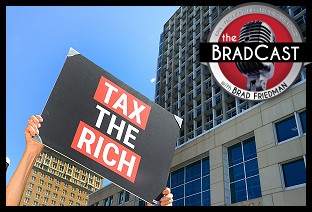 Proposal for 'First Politically Viable Wealth Tax' Takes Shape in CA: 'BradCast' 10/29/25
Proposal for 'First Politically Viable Wealth Tax' Takes Shape in CA: 'BradCast' 10/29/25 Monster Storm, Endless Wars, Gamed Elections:
Monster Storm, Endless Wars, Gamed Elections: 'Green News Report' 10/28/25
'Green News Report' 10/28/25 Let's Play 'Who Wants
Let's Play 'Who Wants Sunday 'Cartoonists Dilemma' Toons
Sunday 'Cartoonists Dilemma' Toons Exiled NOAA Scientists Resurrect Critical Disaster Database: 'BradCast' 10/23/25
Exiled NOAA Scientists Resurrect Critical Disaster Database: 'BradCast' 10/23/25  'Green News Report' 10/23/25
'Green News Report' 10/23/25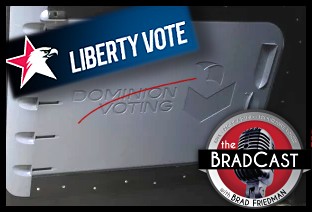 Trump-Allied GOP Partisan Buys Dominion Voting Systems: 'BradCast' 10/22/25
Trump-Allied GOP Partisan Buys Dominion Voting Systems: 'BradCast' 10/22/25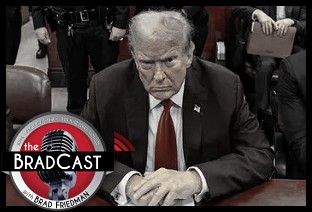 Trump, Republican Law(lessness) & (Dis)Order: 'BradCast' 10/21/25
Trump, Republican Law(lessness) & (Dis)Order: 'BradCast' 10/21/25 'Green News Report' 10/21/25
'Green News Report' 10/21/25 Celebrating 'No Kings': 'BradCast' 10/20/25
Celebrating 'No Kings': 'BradCast' 10/20/25 Sunday 'How It Started' Toons
Sunday 'How It Started' Toons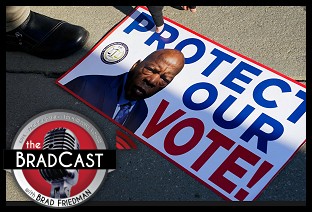 SCOTUS Repubs Appear Ready to Gut Rest of Voting Rights Act: 'BradCast' 10/16/25
SCOTUS Repubs Appear Ready to Gut Rest of Voting Rights Act: 'BradCast' 10/16/25 'Green News Report' 10/16/25
'Green News Report' 10/16/25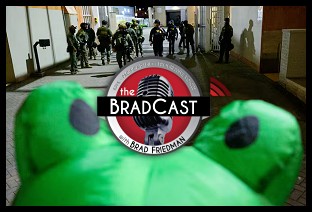 The 'Epstein Shutdown' and Other Autocratic Nightmares: 'BradCast' 10/15/25
The 'Epstein Shutdown' and Other Autocratic Nightmares: 'BradCast' 10/15/25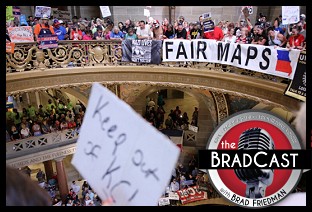 Group Vows to Block MO's GOP U.S. House Gerrymander: 'BradCast' 10/14/25
Group Vows to Block MO's GOP U.S. House Gerrymander: 'BradCast' 10/14/25 Trump Labor Dept. Warns Trump Policies Sparking Food Crisis: 'BradCast' 10/9/25
Trump Labor Dept. Warns Trump Policies Sparking Food Crisis: 'BradCast' 10/9/25 Trump's Losing Battles: 'BradCast' 10/8/25
Trump's Losing Battles: 'BradCast' 10/8/25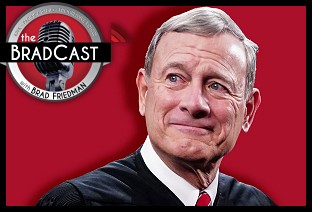 Trump, Roberts and His Stacked, Packed and Captured SCOTUS: 'BradCast' 10/7/25
Trump, Roberts and His Stacked, Packed and Captured SCOTUS: 'BradCast' 10/7/25 Trump Attempting His 'Invasion from Within': 'BradCast' 10/6/25
Trump Attempting His 'Invasion from Within': 'BradCast' 10/6/25 Biden Budget Expert: Mass Firings in Shutdown 'Illegal': 'BradCast' 10/2/25
Biden Budget Expert: Mass Firings in Shutdown 'Illegal': 'BradCast' 10/2/25 Why is DOJ Suing 'Blue' States for Their Voter Databases?: 'BradCast' 10/1/25
Why is DOJ Suing 'Blue' States for Their Voter Databases?: 'BradCast' 10/1/25
 VA GOP VOTER REG FRAUDSTER OFF HOOK
VA GOP VOTER REG FRAUDSTER OFF HOOK Criminal GOP Voter Registration Fraud Probe Expanding in VA
Criminal GOP Voter Registration Fraud Probe Expanding in VA DOJ PROBE SOUGHT AFTER VA ARREST
DOJ PROBE SOUGHT AFTER VA ARREST Arrest in VA: GOP Voter Reg Scandal Widens
Arrest in VA: GOP Voter Reg Scandal Widens ALL TOGETHER: ROVE, SPROUL, KOCHS, RNC
ALL TOGETHER: ROVE, SPROUL, KOCHS, RNC LATimes: RNC's 'Fired' Sproul Working for Repubs in 'as Many as 30 States'
LATimes: RNC's 'Fired' Sproul Working for Repubs in 'as Many as 30 States' 'Fired' Sproul Group 'Cloned', Still Working for Republicans in At Least 10 States
'Fired' Sproul Group 'Cloned', Still Working for Republicans in At Least 10 States FINALLY: FOX ON GOP REG FRAUD SCANDAL
FINALLY: FOX ON GOP REG FRAUD SCANDAL COLORADO FOLLOWS FLORIDA WITH GOP CRIMINAL INVESTIGATION
COLORADO FOLLOWS FLORIDA WITH GOP CRIMINAL INVESTIGATION CRIMINAL PROBE LAUNCHED INTO GOP VOTER REGISTRATION FRAUD SCANDAL IN FL
CRIMINAL PROBE LAUNCHED INTO GOP VOTER REGISTRATION FRAUD SCANDAL IN FL Brad Breaks PA Photo ID & GOP Registration Fraud Scandal News on Hartmann TV
Brad Breaks PA Photo ID & GOP Registration Fraud Scandal News on Hartmann TV  CAUGHT ON TAPE: COORDINATED NATIONWIDE GOP VOTER REG SCAM
CAUGHT ON TAPE: COORDINATED NATIONWIDE GOP VOTER REG SCAM CRIMINAL ELECTION FRAUD COMPLAINT FILED AGAINST GOP 'FRAUD' FIRM
CRIMINAL ELECTION FRAUD COMPLAINT FILED AGAINST GOP 'FRAUD' FIRM RICK SCOTT GETS ROLLED IN GOP REGISTRATION FRAUD SCANDAL
RICK SCOTT GETS ROLLED IN GOP REGISTRATION FRAUD SCANDAL VIDEO: Brad Breaks GOP Reg Fraud Scandal on Hartmann TV
VIDEO: Brad Breaks GOP Reg Fraud Scandal on Hartmann TV RNC FIRES NATIONAL VOTER REGISTRATION FIRM FOR FRAUD
RNC FIRES NATIONAL VOTER REGISTRATION FIRM FOR FRAUD EXCLUSIVE: Intvw w/ FL Official Who First Discovered GOP Reg Fraud
EXCLUSIVE: Intvw w/ FL Official Who First Discovered GOP Reg Fraud GOP REGISTRATION FRAUD FOUND IN FL
GOP REGISTRATION FRAUD FOUND IN FL

































